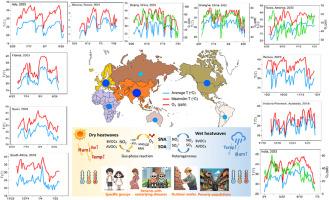全球热浪:趋势、特征、对空气污染和健康影响的范围审查。
IF 7.7
2区 环境科学与生态学
Q1 ENVIRONMENTAL SCIENCES
引用次数: 0
摘要
随着全球气候变化,热浪事件已成为对生态系统和人类健康的严峻挑战。本文对2000年以来的典型热浪事件进行了综合分析和总结,阐明了热浪的定义和分类、全球频率和强度趋势、区域特征及其对大气污染和人类健康的影响。结果表明,全球热浪事件发生的频率和强度呈增加趋势。在热浪事件中,温度、湿度、太阳辐射和大气环流因子对臭氧(O3)、含氮污染物和二次颗粒物的影响显著。在热浪期间,O3浓度与温度呈正相关,然而,在极端高温下,O3浓度的增加速度减慢或甚至被抑制(O3抑制)。热浪通过局部扩散控制、高温、野火和强烈的太阳辐射促进了含氮污染物的产生,特别是活性氮的产生。二次有机气溶胶(SOA)的形成依赖于光化学氧化和非均相反应,高温下异戊二烯的贡献减弱,萜烯的贡献增强。热浪对硝酸盐和硫酸盐的影响方式不同,前者因高温而倾向于以气相存在,而后者则受温度和湿度的综合影响。在热浪期间,高温和臭氧对人类健康产生广泛的负面影响,导致心血管和呼吸系统疾病、中暑和神经异常的风险。全球社会和地方政府应该更多地关注弱势群体,如儿童、老人、孕妇和低收入群体。应制定更多与极端热浪相关的保护措施或政策,如建立高温预警系统,增加绿化面积,提供高温补贴和救助资金。本文章由计算机程序翻译,如有差异,请以英文原文为准。

Global heatwaves: A scoping review on the trend, characteristics, impacts on air pollution and health
With the global climate change, heatwave events have become severe challenges to ecological system and human health. This study presents an integrated analysis and summary on the typical heatwave events since 2000, and elucidates the definitions and classifications of heatwaves, global trends in frequency and intensity, regional characteristics and their impacts on air pollution and human health. It reveals that the global frequency and intensity of heatwave events show an increasing trend. During heatwave events, temperature, humidity, solar radiation, and atmospheric circulation factors exert notable influences on ozone (O3), nitrogen-containing pollutants, and secondary particulate matter. O3 concentrations exhibit a positive correlation with temperature during heatwaves, however, the rate of increase slows down or is even suppressed under extreme high temperatures (O3 suppression). Heatwaves promoted the generation of nitrogen-containing pollutants, particularly reactive nitrogen through localized diffusion control, high temperatures, wildfires, and intense solar radiation. Secondary organic aerosol (SOA) formation relies on the photochemical oxidation and heterogeneous-phase reaction, with the contribution of isoprene weakening and that of terpenes enhancing under high temperatures. Heatwaves influence nitrate and sulfate in different ways: the former tends to exist in gas phase due to high temperature, while the latter is influenced by the combined effects of temperature and humidity. During heatwaves, high temperatures and O3 exert extensive negative effects on human health resulting in risks of cardiovascular and respiratory diseases, heatstroke and neurological abnormalities. Global society and local governments should pay more attention to the vulnerable populations such as the children, elders, pregnant women and low-income groups. More protective measures or policies related to extreme heatwaves should be formulated, such as establishing a high-temperature warning system, increasing green areas, providing high-temperature subsidies and relief funds.
求助全文
通过发布文献求助,成功后即可免费获取论文全文。
去求助
来源期刊

Environmental Research
环境科学-公共卫生、环境卫生与职业卫生
CiteScore
12.60
自引率
8.40%
发文量
2480
审稿时长
4.7 months
期刊介绍:
The Environmental Research journal presents a broad range of interdisciplinary research, focused on addressing worldwide environmental concerns and featuring innovative findings. Our publication strives to explore relevant anthropogenic issues across various environmental sectors, showcasing practical applications in real-life settings.
 求助内容:
求助内容: 应助结果提醒方式:
应助结果提醒方式:


